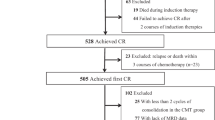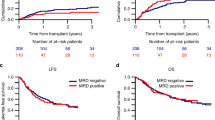Abstract
We assessed by multiparametric flow cytometry the levels of minimal residual disease (MRD) in 100 adult patients with acute myelogenous leukemia (AML) achieving complete remission after intensive chemotherapy. The aim of the study was to determine the optimal threshold, in terms of residual leukemic cells, and the time point of choice, that is, post-induction (post-Ind) or post-consolidation (post-Cons), able to better predict outcome. By applying the maximally selected log-rank statistics, the threshold discriminating MRD− from MRD+ cases was set at 3.5 × 10−4 residual leukemic cells, a level that allowed the identification of distinct subgroups of patients, both at post-Ind and post-Cons time points. Post-Cons MRD− patients had a superior outcome in terms of relapse rate, overall survival (OS) and relapse-free survival (RFS) (P<0.001, for all comparisons), regardless of the MRD status after induction. In particular, patients entering MRD negativity only after consolidation showed the same outcome as those achieving early negativity after induction. Multivariate analysis, including karyotype, age, MDR1 phenotype, post-Ind and post-Cons MRD levels, indicated that the post-Cons MRD status independently affected relapse rate, OS and RFS (P<0.001, for all comparisons). In conclusion: (1) the threshold of 3.5 × 10−4 is valid in discriminating risk categories in adult AML and (2) post-Cons MRD assessment is critical to predict disease outcome.
This is a preview of subscription content, access via your institution
Access options
Subscribe to this journal
Receive 12 print issues and online access
$259.00 per year
only $21.58 per issue
Buy this article
- Purchase on Springer Link
- Instant access to full article PDF
Prices may be subject to local taxes which are calculated during checkout




Similar content being viewed by others
References
Burnett AK, Goldstone AH, Stevens RMF, Hann IM, Rees JK, Gray RG et al. Randomised comparison of addition of autologous bone-marrow transplantation to intensive chemotherapy for acute myeloid leukaemia in first remission: results of MRC 10 trial. Lancet 1998; 351: 700–708.
Harousseau JL, Cahn JY, Pignon B, Witz F, Milpied N, Delain M et al. Comparison of autologous bone marrow transplantation and intensive chemotherapy as postremission therapy in adult acute myeloid leukemia. Blood 1997; 90: 2978–2986.
Bishop JF, Matthews JP, Young GA, Young GA, Szer J, Gillett A et al. A randomized study of high-dose cytarabine in induction in acute myeloid leukemia. Blood 1996; 87: 1710–1717.
Zittoun RA, Mandelli F, Willemze R, de Witte T, Labar B, Resegotti L et al. Autologous or allogeneic bone marrow transplantation compared with intensive chemotherapy in acute myelogenous leukemia. N Engl J Med 1995; 332: 217–223.
Mayer RJ, Davis RB, Schiffer CA, Berg DT, Powell BL, Schulman P et al. Intensive postremission chemotherapy in adults with acute myeloid leukemia. N Engl J Med 1994; 331: 896–903.
Heil G, Hoelzer D, Sanz MA, Lechner K, Liu Yin JA, Papa G et al. A randomized, double-blind, placebo-controlled, phase III study of filgrastim in remission induction and consolidation therapy for adults with de novo acute myeloid leukemia. Blood 1997; 90: 4710–4718.
Campana D, Pui C-H . Detection of minimal residual disease in acute leukemia: methodological advances and clinical significance. Blood 1995; 85: 1416–1434.
Campana D . determination of minimal residual disease in leukemia patients. Br J Haematol 2003; 121: 823–838.
Venditti A, Buccisano F, Del Poeta G, Maurillo L, Tamburini A, Cox C et al. Level of minimal residual disease after consolidation therapy predicts outcome in acute myeloid leukemia. Blood 2000; 96: 3948–3952.
San Miguel JF, Martinez A, Macedo A, Macedo A, Vidriales MB, Lopez-Berges C et al. Immunophenotyping investigation of minimal residual disease is a useful approach for predicting relapse in acute myeloid leukemia patients. Blood 1997; 90: 2465–2470.
San Miguel JF, Vidriales MB, Lopez Berges C, Diaz-Mediavilla J, Gutierrez N, Canizo C et al. Early immunophenptypical evaluation of minimal residual disease in acute myeloid leukemia identifies different patient risk groups and may contribute to postinduction treatment stratification. Blood 2001; 98: 1746–1751.
Kern W, Voskova D, Schoch C, Schnittger S, Hiddemann W, Haferlach T . Prognostic impact of early response to induction therapy as assessed by multiparameter flow cytometry in acute leukemia patients. Haematologica 2004; 89: 528–540.
Venditti A, Tamburini A, Buccisano F, Del Poeta G, Maurillo L, Panetta P et al. Clinical relevance of minimal residual disease detection in adult acute myeloid leukemia. J Hematother Stem Cell Res 2002; 11: 349–357.
Venditti A, Maurillo L, Buccisano F, Tamburini A, Del Poeta G, Del Principe MI et al. Pretransplant minimal residual disease level predicts clinical outcome in patients with acute myeloid leukemia receiving high-dose chemotherapy and autologous stem cell transplantation. Leukemia 2003; 17: 2178–2182.
Kern W, Voskova D, Schoch C, Hiddemann W, Schnittger S, Haferlach T . Determination of relapse risk based on assessment of minimal residual disease during complete remission by multiparameter flow cytometry in unselected patients with acute leukemia. Blood 2004; 104: 3078–3085.
Amadori S, Suciu S, Jehn U, Stasi R, Thomas X, Marie JP et al. Use of glycosylated recombinant human G-CSF (lenograstim) during and/or after induction chemotherapy in patients 61 years of age and older with acute myeloid leukemia: final results of AML-13, a randomized phase 3 study of the European Organisation for Research and Treatment of Cancer and Gruppo Italiano Malattie Ematologiche dell’Adulto (EORTC/GIMEMA) Leukemia Groups. Blood 2005; 106: 27–34.
Del Poeta G, Venditti A, Del Principe MI, Maurillo L, Buccisano F, Tamburini A et al. Amount of spontaneous apoptosis detected by Bax/Bcl-2 ratio predicts outcome in acute myeloid leukemia (AML). Blood 2003; 101: 2125–2131.
Buccisano F, Rossi FR, Venditti A, Del Poeta G, Cox MC, Abbruzzese E et al. CD90/Thy-1 is preferentially expressed on blast cells of high-risk acute myeloid leukaemias. Br J Haematol 2004; 125: 203–212.
Baer MR, Stewart CC, Dodge RK, Leget G, Sule N, Mrozek K et al. High frequency of immunophenotype changes in acute myeloid leukemia at relapse: implication for residual disease detection. Blood 2001; 97: 3574–3580.
Voskova D, Schoch C, Schnittger S, Hiddemann W, Haferlach T, Kern W . Stability of leukemia associated aberrant immunophenotypes in patients with acute leukemia between diagnosis and relapse: comparison with cytomorphologic, cytogenetic and molecular genetic findings. Cytometry 2004; 62b: 25–38.
Hothorn T, Lausen B . On the exact distribution of maximally selected rank statistics. Comput Statist Data Anal 2003; 43: 121–137.
Kaplan EL, Meier P . Non parametric estimations from incomplete observations. J Am Stat Assoc 1958; 53: 457–461.
Cheson BD, Cassileth PA, Head DR, Schiffer CA, Bennett JM, Bloomfield CD et al. Report of the National Cancer Institute-sponsored workshop on definitions of diagnosis and response in acute myeloid leukemia. J Clin Oncol 1990; 8: 813–819.
Zucchetto A, Sonego P, Degan M, Bomben R, Dal Bo M, Bulian P et al. Surface-antigen expression profiling of B cell chronic lymphocytic leukemia: from the signature of specific disease subsets to the identification of markers with prognostic relevance. J Transl Med 2006; 4: 11–16.
Krober A, Seiler T, Benner A, Bullinger L, Bruckle E, Lichter P et al. V(H) mutation status, CD38 expression level, genomic aberrations, and survival in chronic lymphocytic leukemia. Blood 2002; 100: 1410–1416.
Falini B, Mecucci C, Tiacci E, Alcalay M, Rosati R, Pasqualucci L et al. Cytoplasmic nucleophosmin in acute myelogenous leukemia with a normal karyotype. N Engl J Med 2005; 352: 254–266.
Kottaridis PD, Gale RE, Frew ME, Harrison G, Langabeer SE, Belton AA et al. The presence of a FLT3 internal tandem duplication in patients with acute myeloid leukemia (AML) adds important prognostic information to cytogenetic risk group and response to the first cycle of chemotherapy: analysis of 854 patients from the United Kingdom Medical Research Council AML 10 and 12 trials. Blood 2001; 98: 1752–1759.
Keating S, Suciu S, de Witte T, Zittoun R, Mandelli F, Belhabri A et al. The stem cell mobilizing capacity of patients with acute myeloid leukemia in complete remission correlates with relapse risk: results of the EORTC-GIMEMA AML-10 trial. Leukemia 2003; 17: 60–67.
Suciu S, Mandelli F, de Witte T, Zittoun R, Gallo E, Labar B et al. Allogeneic compared with autologous stem cell transplantation in the treatment of patients younger than 46 years with acute myeloid leukemia (AML) in first complete remission (CR1): an intention-to-treat analysis of the EORTC/GIMEMAAML-10 trial. Blood 2003; 102: 1232–1240.
Tallman MS, Gilliland GD, Rowe JM . Drug therapy for acute myeloid leukemia. Blood 2005; 106: 1154–1163.
Acknowledgements
The study was supported in part by Ministero della Salute (Ricerca Finalizzata IRCCS and ‘Alleanza contro il Cancro’), Rome, Italy. We thank Antonella Zucchetto, Clinical and Experimental Hematology Research Unit, CRO Aviano for her support in statistical analyses.
Author information
Authors and Affiliations
Corresponding author
Additional information
Presented in part at the 46th ASH meeting, 4–7 December 2004, San Diego, CA, USA.
Rights and permissions
About this article
Cite this article
Buccisano, F., Maurillo, L., Gattei, V. et al. The kinetics of reduction of minimal residual disease impacts on duration of response and survival of patients with acute myeloid leukemia. Leukemia 20, 1783–1789 (2006). https://doi.org/10.1038/sj.leu.2404313
Received:
Revised:
Accepted:
Published:
Issue Date:
DOI: https://doi.org/10.1038/sj.leu.2404313
Keywords
This article is cited by
-
The menin inhibitor revumenib in KMT2A-rearranged or NPM1-mutant leukaemia
Nature (2023)
-
Reproducible measurable residual disease detection by multiparametric flow cytometry in acute myeloid leukemia
Leukemia (2022)
-
Impact of measurable residual disease by decentralized flow cytometry: a PETHEMA real-world study in 1076 patients with acute myeloid leukemia
Leukemia (2021)
-
Methods and role of minimal residual disease after stem cell transplantation
Bone Marrow Transplantation (2019)
-
Clinical Use of Measurable Residual Disease in Acute Myeloid Leukemia
Current Treatment Options in Oncology (2019)



